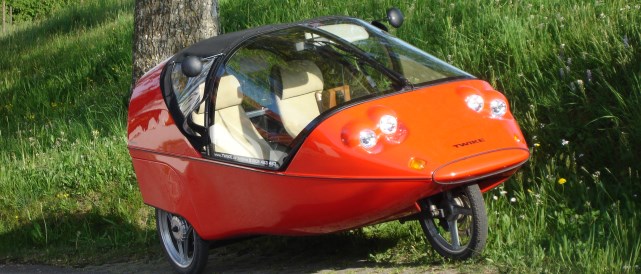All eyes are on Tesla as the only car company that is currently making money on all-electric vehicles. Nonetheless, Craig Morris thinks Tesla is coming at the issue from the wrong end.

A Twike, an alternative electric car that can also be powered by pedaling. (Photo by Franko30)
We can all be thankful to Elon Musk for demonstrating that all-electric vehicles work. Nonetheless, the price tag remains the issue, and Tesla is successful because it sells luxury cars to people for whom the price tag is secondary. But sell the company does – the Tesla is currently beating its German competitors in the US.
While German carmakers continue to be asleep at the wheel when it comes to both hybrids and electric vehicles, the French are much further along – partly, no doubt, because France has that magically domestic source of energy: nuclear.
Renault is at least coming at the issue from the right angle – from the bottom, not the top (like Tesla). The firm’s electric two-seater called the Twizy. It comes at a price tag of only 7,000 euros, though that price does not include a monthly rental contract for the battery. 7,500 kilometers per year will cost you 50 euros a month for the battery.
Now, Renault is rolling out its Zoe in Germany, a more standard-size (though still compact) vehicle. And once again, the price tag does not work. The car itself goes for 21,700 euros in Germany (see the firm’s German website), and as if that were not enough the batteries also have to be rented starting at 79 euros a month. And at that price, you still only get to drive 12,500 kilometers a year or just over 1,000 km a month.
Compare this with a Skoda Fabia Greenline, a five-seater diesel station wagon that is bigger than both of those Renault vehicles but costs less than 18,000 euros – and no monthly battery lease. The Fabia Greenline consumes 3.4 liters per 100 km (83 mpg). (As an owner of the previous model with a rating of 4.1 l/100 km, I can confirm that this consumption value is easy to reach.)
If I purchase this Skoda instead of the Renault Zoe (again, a smaller car), I save around 4,000 euros upfront. And with diesel currently costing around 1.40 euros per liter in Germany, the 79 euros a month for the Zoe’s batteries is enough for me to buy more than 56 liters of diesel (more than the tank holds), with which I can drive more than 1,600 kilometers – far further than the 1,000 kilometers a month for my Renault contract. And I don’t have to worry about recharging.
Clearly, such electric vehicles are far from being affordable or convenient.
But if we come at electric mobility from an even lower level, we see how affordable and convenient it can be. Last year, 10 percent of all bicycles sold in Germany had electric motors, an increase of 15 percent. And though e-bikes can easily cost 2,000 euros, they are inexpensive if they replace a second car for daily trips to work and into town, for instance; range is then also not an issue.
My hope is that another vehicle, the Twike, will eventually become popular. A decade ago, this two-seater electric vehicle with bike pedals inside as a booster for the 2 kW engine cost around 30,000 euros. I thought the price would come down as more people bought it, but the opposite has happened; the vehicle is left in the lurch between less powerful e-bikes and more powerful electric cars.
I would argue that the Twike is the sweet spot for electric mobility: a two-seater with bike pedals (so you can get your exercise) but with a shell to protect you from the rain and a top speed of 90 km/h, so it does not take you forever to reach your destination. And the relatively small 2 kW engine (the Zoe has 65 kW; the Twizy, 13 kW for a top speed of only 80 km/h) would not require nearly as much battery storage to go fast or long (the Twike has a range up to 200 km).
Unfortunately, the price of a Twike has gone nowhere over the past 10 years because the vehicle is still custom-made. But hopefully that gap between e-bike and electric cars will be closed soon and the true future of mass electric individual mobility can begin. We can then start using truly efficient, low-consumption electric mobility for all of those frequent, short daily trips, with fossil fuels and big cars only used for truly long travel.
Craig Morris (@PPchef) is the lead author of German Energy Transition. He directs Petite Planète and writes every workday for Renewables International.
My ‘car’ is a WAW, a velomobile with electro-assist. I bike 36 km (single ride) to work in 1 hour. Electricity consumption is about 0,7 kWh per 100 km, that’s 1500 km with 1 litre of gasoline… Transport becomes sport. http://www.fietser.be.